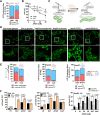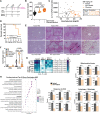Non-canonical BIM-regulated energy metabolism determines drug-induced liver necrosis
- PMID: 38001256
- PMCID: PMC10781779
- DOI: 10.1038/s41418-023-01245-7
Non-canonical BIM-regulated energy metabolism determines drug-induced liver necrosis
Abstract
Paracetamol (acetaminophen, APAP) overdose severely damages mitochondria and triggers several apoptotic processes in hepatocytes, but the final outcome is fulminant necrotic cell death, resulting in acute liver failure and mortality. Here, we studied this switch of cell death modes and demonstrate a non-canonical role of the apoptosis-regulating BCL-2 homolog BIM/Bcl2l11 in promoting necrosis by regulating cellular bioenergetics. BIM deficiency enhanced total ATP production and shifted the bioenergetic profile towards glycolysis, resulting in persistent protection from APAP-induced liver injury. Modulation of glucose levels and deletion of Mitofusins confirmed that severe APAP toxicity occurs only in cells dependent on oxidative phosphorylation. Glycolytic hepatocytes maintained elevated ATP levels and reduced ROS, which enabled lysosomal recycling of damaged mitochondria by mitophagy. The present study highlights how metabolism and bioenergetics affect drug-induced liver toxicity, and identifies BIM as important regulator of glycolysis, mitochondrial respiration, and oxidative stress signaling.
© 2023. The Author(s).
Conflict of interest statement
The authors declare no competing interests.
Figures







Similar articles
-
Role of TRAIL and the pro-apoptotic Bcl-2 homolog Bim in acetaminophen-induced liver damage.Cell Death Dis. 2011 Jun 9;2(6):e171. doi: 10.1038/cddis.2011.55. Cell Death Dis. 2011. PMID: 21654829 Free PMC article.
-
Enhanced Production of Adenosine Triphosphate by Pharmacological Activation of Adenosine Monophosphate-Activated Protein Kinase Ameliorates Acetaminophen-Induced Liver Injury.Mol Cells. 2015 Oct;38(10):843-50. doi: 10.14348/molcells.2015.0072. Epub 2015 Oct 2. Mol Cells. 2015. PMID: 26434492 Free PMC article.
-
Adiponectin protects against acetaminophen-induced mitochondrial dysfunction and acute liver injury by promoting autophagy in mice.J Hepatol. 2014 Oct;61(4):825-31. doi: 10.1016/j.jhep.2014.05.033. Epub 2014 Jun 2. J Hepatol. 2014. PMID: 24882054
-
Zonated induction of autophagy and mitochondrial spheroids limits acetaminophen-induced necrosis in the liver.Redox Biol. 2013 Aug 26;1(1):427-32. doi: 10.1016/j.redox.2013.08.005. Redox Biol. 2013. PMID: 24191236 Free PMC article. Review.
-
Acetaminophen: Dose-Dependent Drug Hepatotoxicity and Acute Liver Failure in Patients.Dig Dis. 2015;33(4):464-71. doi: 10.1159/000374090. Epub 2015 Jul 6. Dig Dis. 2015. PMID: 26159260 Free PMC article. Review.
Cited by
-
Drug-induced oxidative stress actively prevents caspase activation and hepatocyte apoptosis.Cell Death Dis. 2024 Sep 9;15(9):659. doi: 10.1038/s41419-024-06998-8. Cell Death Dis. 2024. PMID: 39245717 Free PMC article.
-
Non-canonical functions of BCL-2 family members in energy metabolism and necrotic cell death regulation.Cell Cycle. 2024 Nov-Dec;23(21-24):931-948. doi: 10.1080/15384101.2025.2484868. Epub 2025 Mar 27. Cell Cycle. 2024. PMID: 40150937 Free PMC article. Review.
-
The phosphatase PPM1F, a negative regulator of integrin activity, is essential for embryonic development and controls tumor cell invasion.BMC Biol. 2025 Jun 19;23(1):166. doi: 10.1186/s12915-025-02254-3. BMC Biol. 2025. PMID: 40537771 Free PMC article.
-
Cell death and cancer: Metabolic interconnections.Cell Rep. 2025 Jun 24;44(6):115804. doi: 10.1016/j.celrep.2025.115804. Epub 2025 Jun 7. Cell Rep. 2025. PMID: 40489330 Free PMC article. Review.
-
Triptonide stabilizes BIM to enhance oxaliplatin-induced ferroptosis and apoptosis in colorectal cancer.Transl Oncol. 2025 Oct;60:102491. doi: 10.1016/j.tranon.2025.102491. Epub 2025 Aug 6. Transl Oncol. 2025. PMID: 40773827 Free PMC article.
References
Publication types
MeSH terms
Substances
Grants and funding
LinkOut - more resources
Full Text Sources
Medical
Molecular Biology Databases

